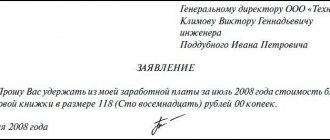Reinstatement of an employee under the Labor Code of the Russian Federation
Only the courts can oblige an employer to reinstate a worker on the basis of Article 391 of the Labor Code of the Russian Federation. That is, restoration, according to Article 394 of the Labor Code of the Russian Federation, is carried out only with an appropriate court decision. Therefore, in case of illegal dismissal, the employee must go to court, and not to the labor inspectorate. The latter cannot issue instructions to the employing company with the relevant requirements. According to Article 428 of the Code of Civil Procedure of the Russian Federation, the reinstatement of an employee is carried out on the basis of a writ of execution.
Article 396 of the Labor Code of the Russian Federation indicates that the decision to reinstate an employee is subject to immediate implementation. The employer is obliged to immediately carry out the procedure even if he plans to appeal the court decision in his favor. This norm is also mentioned in a number of other legal acts:
- The writ of execution must be received before the court decision comes into force, since the requirements are subject to immediate execution. This rule is set out in Articles 211 and 428 of the Code of Civil Procedure of the Russian Federation, Article 396 of the Labor Code of the Russian Federation.
- The requirement stated in the sheet is fulfilled no later than the first working day after the bailiffs receive the paper. The rule is specified in Part 4 of Article 36 of the Federal Law “On Enforcement Proceedings” dated October 2, 2007 No. 229.
- The points of the writ of execution are considered fulfilled if the employer allowed the employee to perform his previous functions and canceled the previously issued dismissal order. This norm is set out in Article 10 of Federal Law No. 229.
Attention! The court decision retains its legal force throughout the Russian Federation.
If the employer was present at the court hearing, then he must comply with the court’s demand the next day. If the head of the organization was not at the meeting, the employee must present him with a writ of execution.
How is an employee reinstated after dismissal?
Within 24 hours from the moment the court makes a decision to reinstate the employee and issue a writ of execution, the employer must allow the employee to perform his job duties, and a corresponding order is issued. The document states:
- that the employee is allowed to perform labor duties with clarification of the position;
- that the previously issued order to terminate the employment contract is cancelled;
- the head of the personnel department is instructed to notify the employee of the date from which he can begin work and of making appropriate corrections to his work book;
- the chief accountant is instructed to pay the employee the average salary for the period of forced absence and the necessary compensation with the obligatory recording of amounts;
- the basis of the order is the writ of execution, its number and date.
Important! The employee must be familiarized with the Order on reinstatement against signature.
A record of the employee’s reinstatement is made on a personal card, where in the “additional information” section it should be written that the employee was reinstated by a court decision, indicating the necessary details, and the record of dismissal should be crossed out. The changes made are certified by the signature of an employee of the HR department. In the work book they write: “Entry No.___ is invalid, reinstated at the previous job” and a link is given to the manager’s order about reinstatement.
Important! It is prohibited in the work book to refer to a court decision or other document, except for the manager’s order for reinstatement.
Recovery procedure
Let's consider the main steps that need to be taken when reinstating an employee.
Cancellation of the previous dismissal order
There are two conditions for reinstatement of an employee: cancellation of the dismissal order and actual admission to work. That is, the employee does not need to be re-employed in the company. It is enough to return everything to normal. To cancel a document, an order must be issued. It states the reason for canceling the previous decision. Other important information is also indicated (for example, details of the court decision).
There is an alternative option, often used by employers, - issuing an additional order that sets out the requirement for reinstatement. The law does not stipulate the form of this document, so the order is drawn up in free form.
However, in any case, the document must contain the employee’s full name, the basis for reinstatement, as well as the date of reinstatement.
If the manager does not issue an order to cancel the previous decision on dismissal, then the document in question includes a requirement for cancellation. If the order is issued on the basis of a court decision that has entered into force, the following data can be entered in it:
- duration of forced absence,
- the amount of payments to the employee for missed days,
- amount of compensation for moral damage.
Important! If an order is issued to cancel the previous one, the employee must be familiarized with it against signature. If an employee refuses to familiarize himself with the order, a special report is drawn up.
Registration of a new work book
It is assumed that upon dismissal an entry was made in the book. Since the decision was challenged in court, this entry should be annulled. To do this, according to Government Resolution No. 225, it must be declared invalid. The serial number is entered in the first column, the date in the second, and an indication of the invalidity of the entry in the third. In the fourth column you need to refer to the order on the basis of which the entry is cancelled. This cancellation procedure is specified in Resolution of the Ministry of Labor No. 69. The employee has the right to demand a duplicate book without making an invalid dismissal record. In this case, o. is placed on the title page of the original document. You need to register its series and number. The new book contains a mark indicating that it is a duplicate.
Re-issuance of a personal card
Upon dismissal, a corresponding entry was made in the personal card. It will also need to be cancelled. The law does not specify the procedure for invalidating a record. Usually the entry is simply crossed out. In section 10 “Additional information” you need to enter recovery data. The details of the writ of execution are indicated.
Filling out a time sheet
The time sheet must be marked with marks for the period of forced absence of the employee. In particular, a digital and alphabetic code is entered: “22” and “PV”. These standards are stipulated by Resolution of the State Statistics Committee No. 1.
These are the general rules used when reinstating an employee.
Recovery procedure
The employer's receipt of a court resolution to return a previously dismissed employee, even if he fundamentally disagrees with it and intends to appeal, must be completed as soon as possible. Any delay will be regarded as evasion and will be grounds for enforcement and a fine. And although the immediate reinstatement of an employee at work by court decision is enshrined in two codes at once, there is no detailed description of this procedure in the regulations. In such cases, one should be guided by established practice, one’s own positive experience and considerations of good faith.
Order
In the case of cancellation of illegal dismissal, it is impossible to use the standard sample in the T-8 form. Indeed, in this order it is necessary not only to resume interrupted labor relations, but to determine further steps and appoint those responsible for their implementation. So the order usually includes:
- recognition that the dismissal was carried out in violation of the law;
- choosing a method to correct the court situation and the employee’s wishes (reinstatement, payment of compensation, changing the wording of the reason for dismissal);
- list of expected payments;
- type of entries in the time sheet and work book.
The basis for fundamental changes will be a court decision or a ruling on a settlement agreement; it should also be indicated in the text of the order for restoration.
On the day of initial dismissal, the name of the former employee is removed from the list of team members and ceases to be mentioned in the time sheet. Since the court, taking the employee’s side, usually obliges the employer to pay not only moral compensation, but also earnings for the period of forced absence, this must be indicated in the appropriate report card.
As soon as the judge announces his decision, the manager must order the personnel officers to make corrections to the documents recording hours worked. In the supplemented line, you need to enter the full name of the reinstated employee, his position, and in the cells opposite the calendar numbers, enter the designation PV or numerical code 22.
The reinstatement of an employee at work by a court decision will give him grounds to demand that management correct the entries in his work book. This is especially important if the dismissal was carried out on the basis of the employee’s guilty actions, as a disciplinary sanction, or due to loss of trust. After all, no one wants to spend their whole life making excuses for such an “indecent” recording.
We invite you to familiarize yourself with the Costs of a representative: collection cannot be refused
The procedure for entering new information is determined by Instruction 69 on maintaining work books. Since this document does not provide for strikethroughs, the correction is made by adding a new entry with the next serial number. It must be mentioned that the previous line is invalid. The correct entry is made with new wording under the next serial number.
The court decision to restore the employee’s labor rights is subject to immediate execution not only in terms of returning the person to his position, but also the payment of monetary payments awarded to him. Moreover, in this case, it does not matter whether the employer agrees with these conclusions and whether he intends to appeal them. You need to pay as soon as possible:
- accrued average earnings during forced absence, art. 139 Labor Code of the Russian Federation;
- the amount of moral and material damage;
- lost severance payments, if the previous formulation of the reasons for the calculation did not allow the employee to receive them on time;
- indexation and other amounts recognized by the court.
Another unpleasant point in the event of a labor dispute is that if the employer’s appeal is satisfied and the newly reinstated specialist is re-dismissed, the money paid cannot be returned. An attempt to return funds will be successful only for those who can prove that the employee intentionally provided false information to the court, Art. 397 Labor Code of the Russian Federation.
Permission to work
If both parties are present when the judge announces the decision, then it is better for the employer’s representative not to waste time and immediately give the employee a notice about the conditions for resuming cooperation and the timing of returning to work.
If for some reason the moment is missed, then every effort must be made to find an effective way to notify the reinstated employee in a short time. The fact is that every day of his absence from work after the announcement of the court decision will be interpreted as forced absence if the person was not informed how and when to return to his place. It is clear that the employer must pay for these days.
There are several ways to report reinstatement:
- in person – delivery of a written document against signature;
- by mail - with an inventory and notification;
- by telegram - its text must be certified;
- by telephone message or SMS from a corporate phone number.
It is also necessary to understand that it is necessary to restore not only to the previous position, the employee must receive back all rights and access to documents, information and types of work. Even if he was fired for a proven violation in this area, but there was a procedural mistake, everything should return to normal. Removal of trade secrets or restriction of access will be regarded as interference in the performance of official duties and failure to comply with a court decision.
Some nuances of the procedure
Employee reinstatement involves the following features:
- The period of forced absenteeism (and in case of illegal dismissal the absenteeism will be forced) is included in the length of service on the basis of which annual leave is granted. For example, an organization must provide annual leave to an employee after he has worked for six months. The employee worked for 5 months, after which he was illegally fired. The forced absence lasted a month. In this case, the total time of service in the organization will be 6 months. That is, the employee receives the right to paid leave. This norm is specified in Part 1 of Article 121 of the Labor Code of the Russian Federation.
- What to do if another person is already working in the position of the fired employee? The reinstatement of an employee is the basis for the dismissal of a new employee who has entered the position. These norms are specified in Articles 77 and 83 of the Labor Code of the Russian Federation. However, if possible, the employee should be offered a different position. If an employee refuses a position, he must be accrued severance pay equal to 2 weeks' earnings. The norm is defined in Article 178 of the Labor Code of the Russian Federation.
- If the schedule does not contain the position in which the reinstated employee worked, appropriate changes must be made. An alternative option is to draw up a staffing table. An order is issued.
Most of the nuances during restoration are set out in the Labor Code of the Russian Federation.
Some recovery features
| Circumstances | Employer's actions | Employee payments |
| A fired person wants to return to his previous job. | You need to be reinstated in your position, salary and security clearance from the date the court decision was announced. The insurance period during the consideration of the dispute will also be counted for sick leave and vacation. | Pay for forced absence, calculate compensation for vacation days accumulated during this time (minimum 2.33 per month, Article 115 of the Labor Code). |
| The dismissed man was reinstated by court decision, but changed his mind about returning after it was made public | The employee must be reinstated in accordance with the document received from the court. He can submit his resignation letter on the first day of work. You can fire him again either at your own request or by agreement of the parties. In this case, the employer has the right to demand work off, Art. 80 TK. | Average earnings during absenteeism, Art. 139 TK. Vacation compensation, art. 140 TK. For the time worked, you need to calculate the remaining salary. |
| The dismissed person refused to be reinstated while still in court or has already found another job | In this case, there is no talk of returning to the performance of former duties. The court approves the amount of compensation payments. In this case, the employee is not obliged to go to work and management cannot require any prior warning about this. | Average earnings during absenteeism, Art. 139 TK. Vacation compensation |
| The court declared the transfer to another position illegal | Reinstate on the day the decision is announced | Pay the difference in wages for the past period. |
It may happen that another invited specialist is already working in place of the fired person. As sad as it may be for a newcomer, the procedure for reinstatement of a former employee by a court decision provides for the immediate dismissal of the newly hired employee. Only those who agree to the transfer can stay behind if the company has unfilled vacancies.
In this situation, an offer of lower paid positions will be considered legal. Even the dismissal of a pregnant woman will be considered lawful, since Art. 261 of the Labor Code of the Russian Federation protects expectant mothers only from termination of an employment contract at the initiative of the employer, and here we are talking about clause 2) of Art. 83 of the Labor Code of the Russian Federation (for independent reasons). The only small consolation will be the payment of severance pay in the amount of two weeks’ average earnings, Art. 178 TK.
In the event of complete liquidation of an enterprise, it is simply impossible to talk about reinstatement in the workplace. Since the illegally dismissed employee has nowhere to return, the court will decide only the amount and method of compensation for damage, as well as payment for absenteeism.
Hope of obtaining a job can only remain for those whose employer was liquidated through reorganization or appointed a successor. Then the judge may take the employee’s side and oblige the new manager to accept into the team the person who was wrongfully fired from the reorganized company.
Payments upon restoration
When reinstating an employee, you need to make 2 categories of payments:
- Salary for the period of forced absence . Calculated based on the average employee salary. First, the average daily income is found (the employee’s total income for the current year is divided by the number of days since the beginning of the year), and then the indicator is multiplied by the number of days of forced absence.
- Compensation for moral damage . It is paid only if the employee indicated the corresponding requirement in the claim. The exact amount of compensation is determined by the court.
Payments to an employee are reflected in accounting as wages. In essence, this is the salary that the employee did not receive on time due to the fault of the employer.
Reinstatement
The reinstatement of an employee at work presupposes that there was no termination of the employment contract, and therefore the employment relationship has not been terminated. All terms of the agreement are again considered valid.
All that time from the moment of illegal dismissal of an employee until the moment of his reinstatement is recognized as forced absenteeism, that is, absenteeism due to the fault of the employer, and not the employee. During all this time, the employee must be paid the average salary. In addition, this entire period of time is included in the total length of service and entitles the employee to the leave granted annually to employees.
Important! The entire time from the moment the employee is dismissed until his reinstatement is included in the length of service that gives the right to vacation.
Payments
When a person is reinstated at his place of work, the court in enforcement proceedings decides to collect wages from the company's management in favor of the employee for the downtime. The decision to pay wages for three months must also be executed immediately. The obligation to make all other payments due to the specialist (sick leave pay, compensation for moral damage, payment of legal costs, etc.) occurs when the court decision enters into legal force.
Reinstatement of a dismissed person through the court is a complex procedure that requires the re-issuance of many documents. It is possible not only in case of illegal dismissal, but also when the procedure itself was carried out with errors and violations.
Cancellation of a dismissal order in court
Cancellation of an order to dismiss an employee may be necessary in the following situations:
- the employer realized that he fired the specialist by mistake, so he is going to cancel the dismissal of his own free will;
- the employee filed a claim in court, where it was decided to reinstate him in his previous position.
In the first situation, the management of the organization does not have the right to independently, i.e., without the voluntary consent of the employee himself, decide to reinstate him in the workplace, for example, if it was revealed that there was no disciplinary violation or a reduction in staff was cancelled. An order to cancel a dismissal cannot be issued unless the consent of the dismissed person is given. The employee has the right to appeal to the court to cancel the dismissal, however, he may agree to resolve this issue pre-trial.
In the second situation, employers often doubt whether it is necessary to issue an order to cancel the dismissal, or whether an order should be issued to reinstate the employee. Here you can dwell on the cancellation of dismissal with a description of the reasons, in this case, a court decision. Here you can also indicate the amount of financial compensation due to the employee and the number of days of downtime. But, most often, the management of the organization simply issues an additional order to reinstate the dismissed person at his place of work. Sample orders can be found on legal portals. Such actions do not contradict the law.
Employer's liability for failure to comply with a court decision
Failure to comply with a court decision by an employer falls under an offense under Art. 17.15 of the Code of Administrative Offenses of the Russian Federation, and threatens to impose an administrative fine on an official from 10,000 to 20,000 rubles, on a legal entity - from 30,000 to 50,000 rubles.
At the same time, paying a fine does not relieve the employer of the obligation to restore violated rights.
In case of non-execution of a court decision, a citizen has the right to turn to bailiffs and demand to force the employer to comply with the court decision. And time of non-fulfillment is regarded as forced absence and, accordingly, is subject to payment according to average earnings.
Legislation
The ability of an employee who has been fired to appeal to the courts in order to protect his own labor rights is defined in Article 392 of the Russian Labor Code.
In matters related to the dismissal procedure, a specific period is established for this - thirty days from the date of leaving work. You should contact the court located at your residential address. If, after the case has been considered, the court decides to return the employee to his place of work, it must be executed immediately. This requirement is specified in Article 396 of the Labor Code of the Russian Federation. If the decision is not executed, the employer will be fined in the following amounts:
- from ten to twenty thousand rubles - for the employer who is responsible for the violation;
- from thirty to fifty thousand rubles - for the company where the dismissed employee worked.
These fine amounts are established by Article 17.15 of the Code of Administrative Offenses of the Russian Federation. In addition to paying the fine, the employer will also have to reinstate the person to his previous position in the new term.
If this requirement is ignored by him again, the next larger fine will be imposed.







